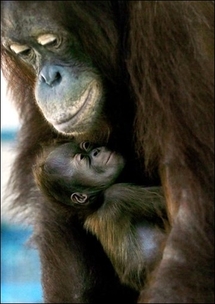
The area of change, in which sequences of DNA code become duplicated, abruptly accelerated, and could account for the evolutionary break, the study found.
It may shed light on something that has long puzzled scientists: why humans and chimps look and behave so differently, even though they have what is commonly thought to be a nearly identical genetic heritage.
Their genomes overlap by nearly 99 percent, and their proteins are virtually the same, earlier research has shown.
But the new study found that the number and range of duplicated sequences vary much more than the other portions of genetic code.
"It is unclear why, but the common ancestor of humans, chimps and gorillas had an unusual activity of duplication," said Jeffrey Kidd of the University of Washington and co-leader of the study.
This genetic shift may have resulted from changes in population size, lifespan or an instability in the genome, he speculated.
Whatever the cause, it likely "had a profound impact on the reproductive success, adaptability and evolution of ancestral hominid populations," the study said.
To probe the patterns of genomic duplication during evolution, Kidd and his colleagues compared telltale sequences in four primates: the macaque, orangutan, chimpanzee and human.
Only a fraction of these copied segments were unique to each species, which suggests that the vast number of these duplications must have occurred before the evolutionary split, in a common ancestor.
The study also showed that these regions are changing much more rapidly than most others.
"The next challenge will be making sense of all these differences and the genes that affect them," said the study's co-leader, Tomas Marques-Bonet, also a researcher at the University of Washington.
The paper is published in the London-based science journal Nature.
--------------------------------------------
Image of eight-year-old orangutan cradling her seven-day-old baby at Ragunan zoo in Jakarta in 2006, by Adek Berry.
It may shed light on something that has long puzzled scientists: why humans and chimps look and behave so differently, even though they have what is commonly thought to be a nearly identical genetic heritage.
Their genomes overlap by nearly 99 percent, and their proteins are virtually the same, earlier research has shown.
But the new study found that the number and range of duplicated sequences vary much more than the other portions of genetic code.
"It is unclear why, but the common ancestor of humans, chimps and gorillas had an unusual activity of duplication," said Jeffrey Kidd of the University of Washington and co-leader of the study.
This genetic shift may have resulted from changes in population size, lifespan or an instability in the genome, he speculated.
Whatever the cause, it likely "had a profound impact on the reproductive success, adaptability and evolution of ancestral hominid populations," the study said.
To probe the patterns of genomic duplication during evolution, Kidd and his colleagues compared telltale sequences in four primates: the macaque, orangutan, chimpanzee and human.
Only a fraction of these copied segments were unique to each species, which suggests that the vast number of these duplications must have occurred before the evolutionary split, in a common ancestor.
The study also showed that these regions are changing much more rapidly than most others.
"The next challenge will be making sense of all these differences and the genes that affect them," said the study's co-leader, Tomas Marques-Bonet, also a researcher at the University of Washington.
The paper is published in the London-based science journal Nature.
--------------------------------------------
Image of eight-year-old orangutan cradling her seven-day-old baby at Ragunan zoo in Jakarta in 2006, by Adek Berry.









 Home
Home Politics
Politics









